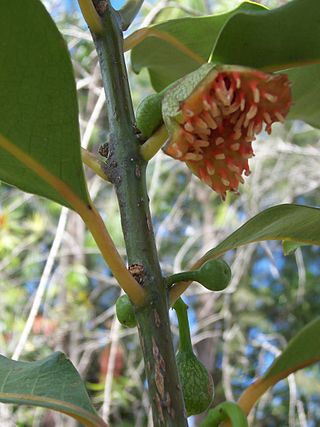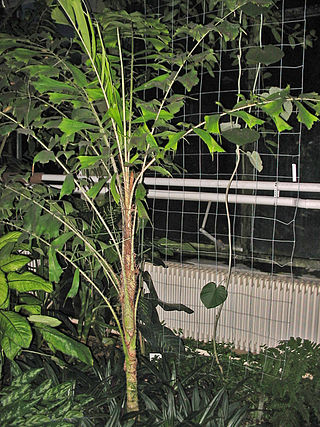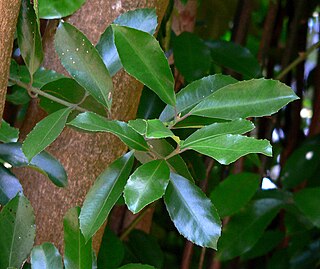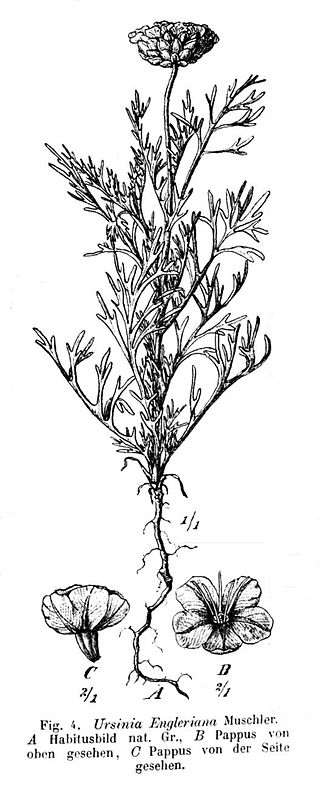
Abelia is a previously recognized genus that contained about 30 species and hybrids, placed in the honeysuckle family, Caprifoliaceae. Molecular phylogenetic studies showed that the genus was not monophyletic, and in 2013, Maarten Christenhusz proposed the merger of Abelia into Linnaea, along with some other genera. Abelia section Zabelia was raised to the genus Zabelia.

The Monimiaceae is a family of flowering plants in the magnoliid order Laurales. It is closely related to the families Hernandiaceae and Lauraceae. It consists of shrubs, small trees, and a few lianas of the tropics and subtropics, mostly in the southern hemisphere. The largest center of diversity is New Guinea, with about 75 species. Lesser centres of diversity are Madagascar, Australia, and the neotropics. Africa has one species, Xymalos monospora, as does Southern Chile. Several species are distributed through Malesia and the southwest Pacific.

Aiphanes is a genus of spiny palms which is native to tropical regions of South and Central America and the Caribbean. There are about 26 species in the genus, ranging in size from understorey shrubs with subterranean stems to subcanopy trees as tall as 20 metres (66 ft). Most have pinnately compound leaves ; one species has entire leaves. Stems, leaves and sometimes even the fruit are covered with spines. Plants flower repeatedly over the course of their lifespan and have separate male and female flowers, although these are borne together on the same inflorescence. Although records of pollinators are limited, most species appear to be pollinated by insects. The fruit are eaten by several birds and mammals, including at least two species of amazon parrots.

Linnaea is a plant genus in the honeysuckle family Caprifoliaceae. Until 2013, the genus included a single species, Linnaea borealis. In 2013, on the basis of molecular phylogenetic evidence, the genus was expanded to include species formerly placed in Abelia, Diabelia, Dipelta, Kolkwitzia and Vesalea. However, this is rejected by the majority of subsequent scientific literature and flora.

Aiphanes duquei is a species of palm that is endemic to Colombia. Known from only a small area in the Cordillera Occidental, it is threatened by habitat loss and forest management practices.

Schippia concolor, the mountain pimento or silver pimeto, is a medium-sized palm species that is native to Belize and Guatemala. Named for its discoverer, Australian botanist William A. Schipp, the species is threatened by habitat loss. It is the sole species in the genus Schippia.

Wodyetia bifurcata, the foxtail palm, is a species of palm in the family Arecaceae, native to Queensland, Australia. It is the sole species in the genus Wodyetia.

Helicia is a genus of 110 species of trees and shrubs, constituting part of the plant family Proteaceae. They grow naturally in rainforests throughout tropical South and Southeast Asia, including India, Sri Lanka, Indochina, Peninsular Malaysia to New Guinea and as far south as New South Wales.
Mollinedia argyrogyna is a species of plant in the Monimiaceae family. It is endemic to Brazil. It is threatened by habitat loss.

Mollinedia is a genus of flowering plants in the family Monimiaceae. There are 56 species distributed in the forests of the Neotropics, ranging from central Mexico to southern Brazil. They are mainly shrubs and trees.
Mollinedia butleriana is a species of plant in the Monimiaceae family. It is endemic to Honduras.
Mollinedia glabra is a species of plant in the Monimiaceae family. It is endemic to Brazil. It is threatened by habitat loss.
Mollinedia lamprophylla is a species of plant in the Monimiaceae family of the Laurales oeder.
Mollinedia marquetiana is a species of plant in the Monimiaceae family. It is endemic to Brazil. It is threatened by habitat loss.
Mollinedia ruae is a species of plant in the Monimiaceae family. It is found in Honduras and Nicaragua.
Passiflora linda is a species of plant in the family Passifloraceae. It is endemic to Ecuador. The species was named in honor of botanist Linda Katherine Escobar.
Dryobalanops beccarii, or Kapur Keladan, is a species of plant in the family Dipterocarpaceae. The species is named after Odoardo Beccari, 1843–1920, an Italian explorer and botanist. It is found in Peninsular Malaysia and Borneo. It is a large emergent tree, up to 65 m tall, found in mixed dipterocarp forests on shallow leached soils over both sandstone and shale. It is a heavy hardwood sold under the trade names of Kapur. It is recorded from at least four protected areas.

Hedycarya is a genus of dioecious trees and shrubs of the family Monimiaceae. It includes 16 species native to eastern Australia, New Zealand, Fiji, New Caledonia, the Samoan Islands, Tonga, and Vanuatu. The genus was named and formerly described in 1776 by botanists Johann and Georg Forster in Characteres Generum Plantarum. The limit of the genus may require change as it appears paraphyletic in phylogenetic analyses, with the genera Kibaropsis and Levieria nested in it.

Ursinia nana DC. is an annual herb belonging to the daisy family of Asteraceae. It native to Africa, where it has a disjunct distribution in northeastern Africa and southern Africa. It is a pioneer plant of disturbed ground and usually grows to a height of only 30 cm. It flowers throughout the rainy season and, in mild weather with late rains, well into the autumn months. The leaves are deeply laciniate and bunched. In his 1912 contribution to Botanische Jahrbücher für Systematik, Pflanzengeschichte und Pflanzengeographie, the enigmatic German botanist Reinhold Conrad Muschler describes Ursinia engleriana, found near Okahandja in South West Africa, as a new species of African composite. Later this was considered to be the same as Ursinia nana described by de Candolle. Muschler praised the species as being extremely ornamental.
Aediesia is a genus of African plants in the tribe Vernonieae tribe within the family Asteraceae.











